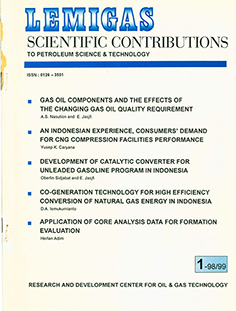Application Of Core Analysis Data For Formation Evaluation
DOI:
https://doi.org/10.29017/SCOG.21.1.954Keywords:
Analysis, Evaluation, IntegrationAbstract
The primary goal of most reservoir evaluation studies is the integration of data from various sources to indentify zones with similar fluid flow characteristic, and to define the areal and lateral continuity of such zones. Core data developed on rock samples recovered from a formation or interest zone which a play vital role in exploration programs, well completion and workover operations and in well and reservoir evaluation. Coring is the only mean of obtaining an actual sample of an oil bearing formation to study. These cores, with proper handling and preservation, are used to obtained data which permit accurate evaluation of the oil or gasreservoirs. This paper presents a practical used of core analysis data for formation evaluation of reservoir hydrocarbon and to provide information that will be of practical value to geologists and engineers involved with the interpretation of core analysis data.
References
Amyx, J.W., Bass, D.M. JR. and Whiting, R.L., 1960, Petroleum Reservoir Engineering-Physical Properties, McGraw-Hill Book Co., New York
Arps, J.J., 1964, “Engineering concept useful in oil findingâ€, AAPG Bull., vol.48, no.2, p.157-165
Jennings, J.B., 1987, “Capillary pressure techniques :â€Application to exploration and development geologyâ€, American Association of Petroleum Geologist. Bulletin, 71, 1196 – 1209.
Keelan, D.K., Koeph, E.M., 1977, “The Role of Cores and Core Analysis in Evaluation for Formation Damageâ€, Journal Petroleum Tech, May, pp 482-490.
Ratkolo, T., 1992, “Penentuan Kualitas Bantuan Reservoar dengan Menggunakan Metode Tekanan Kapiler dengan Injeksi Merkuriâ€, Diskusi Ilmiah VII, Hasil Penelitian LEMIGAS, Jakarta.
Downloads
Issue
Section
License
Copyright (c) 1970 SCIENTIFIC CONTRIBUTIONS OIL AND GAS (SCOG)

This work is licensed under a Creative Commons Attribution 4.0 International License.
Authors are free to Share — copy and redistribute the material in any medium or format for any purpose, even commercially Adapt — remix, transform, and build upon the material for any purpose, even commercially.
The licensor cannot revoke these freedoms as long as you follow the license terms, under the following terms Attribution — You must give appropriate credit , provide a link to the license, and indicate if changes were made . You may do so in any reasonable manner, but not in any way that suggests the licensor endorses you or your use.
No additional restrictions — You may not apply legal terms or technological measures that legally restrict others from doing anything the license permits.














